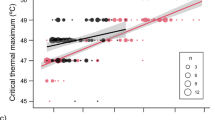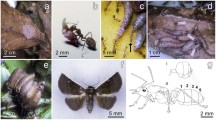Summary
Three lines of evidence, including interspecific comparisons, temporal division of foraging between size castes, and experimental manipulations, suggest that the diurnal parasitoid Neodohrniphora curvinervis (Diptera: Phoridae) influences both the caste sizes and numbers of leaf-cutter ants (Atta cephalotes) that leave their underground nests to collect leaves. At Parque Nacional Corcovado in Costa Rica, A. cephalotes was attacked by Neodohrniphora during the daytime, and foraged less during the day than at night; a closely related ant at the same site, A. colombica, had no phorid parasites and foraged exclusively during the day. Most daytime foragers of A. cephalotes were smaller than the lower size threshold for attack by Neodohrniphora, while nocturnal foragers, active when parasitoids were absent, were both larger than this threshold and within the energetically optimal size range for foraging. When I supplied artificial lighting to allow phorids to hunt at A. cephalotes colonies past dusk, ants foraged less than when light was provided but flies were removed. The influence of Neodohrniphora on the foraging activity of A. cephalotes may explain why investigations focusing on abiotic factors have largely failed to discover what drives this ant's daily foraging cycles, and suggests that forager sizes are influenced not only by energetic efficiency, but also by the threat of parasitism.
Similar content being viewed by others
References
Belt T (1874) The Naturalist in Nicaragua. JM Dent and Sons, London
Boyd ND, Martin MM (1975) Faecal proteinases of the fungus-growing ant, Atta texana: their fungal origin and ecological significance. J Insect Physiol 21:1815–1820
Brown BV, Feener DH (1991a) Behavior and host location cues of Apocephalus paraponerae (Diptera: Phoridae), a parasitoid of the giant tropical ant, Paraponera clavata (Hymenoptera: Formicidae). Biotropica 23:182–187
Brown BV, Feener DH (1991b) Life history parameters and description of the larva of Apocephalus paraponerae (Diptera: Phoridae), a parasitoid of the giant tropical ant Paraponera clavata (Hymenoptera: Formicidae). J Nat Hist 25:221–231
Bullock TH, Horridge GA (1965) Structure and function in the nervous system of invertebrates. W.H. Freeman & Co, London
Cherrett JM (1968) The foraging behavior of Atta cephalotes. J Anim Ecol 37:387–403
Eibl-Eibesfeldt I, Eibl-Eibesfeldt E (1967) Das Parasitenabwehren der Minima-Arbeiterinnen der Blattschneider-Ameise (Atta cephalotes). Z Tierpsychol 24:278–281
Feener DH (1987) Size-selective oviposition in Pseudacteon crawfordi (Diptera: Phoridae), a parasite of fire ants. Ann Entom Soc Am 80:148–151
Feener DH (1988) Effects of parasites on foraging and defense behavior of a termitophagous ant, Pheidole titanis Wheeler. Behav Ecol Sociobiol 22:421–427
Feener DH, Brown BV (1992) Reduced foraging of the tropical fire ant, Solenopsis geminata (Hymentopter: Formicidae), in the presence of parasitic phorid flies, Pseudacteon spp. (Diptera: Phoridae). Ann Ent Soc Am 85:80–84
Feener DH, Moss KAG (1990) Defense against parasites by hitchhikers in leaf-cutting ants: a quantitative assessment. Behav Ecol Sociobiol 26:17–29
Hodgson ES (1955) An ecological study of the behavior of the leafcutting ant Atta cephalotes. Ecology 36:293–304
Lewis T, Pollard GV, Dibley GC (1974a) Rhythmic foraging in the leaf-cuting ant Atta cephalotes (L.) (Formicidae: Attini). J Anim Ecol 43:129–141
Lewis T, Pollard GV, Dibley GC (1974b) Microenvironmental factors affecting diel patterns of foraging in the leaf-cutter ant Atta cephalotes. J Anim Ecol 43:143–153
Lutz FE (1929) Observations on leaf-cutting ants. Am Mus Novit 388:1–21
Nonacs P, Dill LM (1990) Mortality risk vs. food quality trade-offs in a common currency: ant patch preferences. Ecology 71(5):1886–1892
Pergande T (1901) The ant-decapitating fly. Proc Entomol Soc Wash 4:497–502
Rockwood LL (1975) The effects of seasonality on foraging in two species of leafcutting ants (Atta) in Guanacaste Province, Costa Rica. Biotropica 7:176–193
SAS Institute (1989) Box 8000, Cary, NC 27511
Tosi JA (1969) Mapa ecologico, Republica de Costa Rica: según la clasificacion de zonas de vida del mundo de LR Holdridge. Centro Cientifico Tropical, San Jose
Weber NA (1966) Fungus growing ants and soil nutrition. (Monogr. 1, Progresos en biologia de suelo.) Actas del primer coloquio Latinoamericano de biologia del suelo UNESCO, Montevideo; 221–256
Weber NA (1972) Gardening ants: the attines. Mem Am Phil Soc 92:1–146
Wetterer J (1988) Size-selective foraging by leaf-cutting ants and planktivorous fish. (PhD dissertation). University of Washington, Seattle
Wilson EO (1980a) Caste and division of labor in leaf-cutter ants. I. The overall pattern in Atta sexdens. Behav Ecol Sociobiol 7:143–156
Wilson EO (1980b) Caste and division of labor in leaf-cutting ants. II. The ergonomic organization of leaf-cutting. Behav Ecol Sociobiol 7:157–165
Wilson EO (1983a) Caste and division of labor in leaf-cutter ants. III. Ergonomic resiliency in foraging by Atta cephalotes. Behav Ecol Sociobiol 14:47–54
Wilson EO (1983b) Caste and division of labor in leaf-cutter ants. IV. Colony ontogeny of A. cephalotes. Behav Ecol Sociobiol 14:55–60
Author information
Authors and Affiliations
Rights and permissions
About this article
Cite this article
Orr, M.R. Parasitic flies (Diptera: Phoridae) influence foraging rhythms and caste division of labor in the leaf-cutter ant, Atta cephalotes (Hymenoptera: Formicidae). Behav Ecol Sociobiol 30, 395–402 (1992). https://doi.org/10.1007/BF00176174
Received:
Accepted:
Issue Date:
DOI: https://doi.org/10.1007/BF00176174




